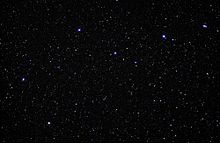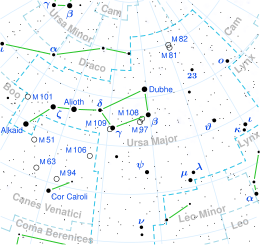Alcor (star)
Location of Alcor (Mizar is circled, Alcor is invisible beside it at this scale) | |
| Observation data Epoch J2000.0 Equinox J2000.0 | |
|---|---|
| Constellation | Ursa Major |
| Right ascension | 13h 25m 13.53783s[1] |
| Declination | +54° 59′ 16.6548″[1] |
| Apparent magnitude (V) | +3.99[2] |
| Characteristics | |
| Spectral type | A5Vn[3] / M3-4[4] |
| Astrometry | |
| Radial velocity (Rv) | −9.6[5] km/s |
| Parallax (π) | 39.91 ± 0.13 mas[1] |
| Distance | 81.7 ± 0.3 ly (25.06 ± 0.08 pc) |
| Absolute magnitude (MV) | +2.00[2] |
| Details | |
| Alcor A | |
| Mass | 1.84[6] M☉ |
| Radius | 1.846[7] R☉ |
| Luminosity | 14.03[6] L☉ |
| Surface gravity (log g) | 4.25[8] cgs |
| Temperature | 8,221[8] K |
| Rotational velocity (v sin i) | 228[6] km/s |
| Alcor B | |
| Mass | 0.25[4] M☉ |
| Age | 0.5 ± 0.1[2] Gyr |
| Other designations | |
| Database references | |
| SIMBAD | data |
Alcor (/ˈælkɔːr/)[9] is a binary star system in the constellation of Ursa Major. It is the fainter companion of Mizar, the two stars forming a naked eye double in the handle of the Big Dipper (or Plough) asterism in Ursa Major. The two both lie about 83 light-years away from the Sun, as measured by the Hipparcos astrometry satellite.
Nomenclature[edit]
Alcor has the Flamsteed designation 80 Ursae Majoris. Alcor derives from Arabic الخوار al-khawāri, meaning 'faint one';[10][11][12] notable as a faintly perceptible companion of Mizar.[13]
In 2016, the International Astronomical Union organized a Working Group on Star Names (WGSN)[14] to catalog and standardize proper names for stars. The WGSN's first bulletin of July 2016[15] included a table of the first two batches of names approved by the WGSN; which included Alcor for 80 UMa.[16]
Mizar and Alcor[edit]

With normal eyesight Alcor appears at about 12 minutes of arc from the second-magnitude star Mizar. Alcor is of magnitude 3.99 and spectral class A5V.
Mizar's and Alcor's proper motions show they move together, along with most of the other stars of the Big Dipper except Dubhe and Alkaid, as members of the Ursa Major Moving Group, a mostly dispersed group of stars sharing a common birth. However, it has yet to be demonstrated conclusively that they are gravitationally bound. Recent studies indicate that Alcor and Mizar are somewhat closer together than previously thought: approximately 74,000 ± 39,000 AU, or 0.5–1.5 light-years. The uncertainty is due to our uncertainty about the exact distances from us. If they are exactly the same distance from us (somewhat unlikely) then the distance between them is only 17,800 AU (0.281 light-years).[2]
Alcor B[edit]

In 2009, Alcor was discovered to have a companion star Alcor B, a magnitude 8.8 red dwarf.[17]
Alcor B was discovered independently by two groups. One group led by Eric Mamajek (University of Rochester) and colleagues at Steward Observatory University of Arizona used adaptive optics on the 6.5-meter telescope at MMT Observatory. Another led by Neil Zimmerman, a graduate student at Columbia University and member of Project 1640, an international collaborative team that includes astrophysicists at the American Museum of Natural History, the University of Cambridge's Institute of Astronomy, the California Institute of Technology, and NASA's Jet Propulsion Laboratory, used the 5-meter Hale Telescope at Palomar Observatory.[4]
Alcor B is one second of arc away from Alcor A.[4] Its spectral type is M3-4 and it is a main-sequence star, a red dwarf.
Alcor A and B are situated 1.2 light-years away from, and are co-moving with, the Mizar quadruple system, making the system the second-closest stellar sextuplet—only Castor is closer.[18] The Mizar–Alcor stellar sextuple system belongs to the Ursa Major Moving Group, a stellar group of stars of similar ages and velocities,[2] and the closest cluster-like object to Earth.
Other names[edit]
In Arabic, Alcor is also known as Al-Sahja (the rhythmical form of the usual al-Suhā) meaning 'forgotten', 'lost', or 'neglected'.[19]
In traditional Indian astronomy,[20] Alcor was known as Arundhati, wife of one of the Saptarishi.
In the Miꞌkmaq myth of the great bear and the seven hunters,[21] Mizar is Chickadee and Alcor is his cooking pot.
Military namesakes[edit]
USS Alcor (AD-34) and USS Alcor (AK-259) are both United States Navy ships.
References[edit]
- ^ a b c van Leeuwen, F. (November 2007). "Validation of the new Hipparcos reduction". Astronomy and Astrophysics. 474 (2): 653–664. arXiv:0708.1752. Bibcode:2007A&A...474..653V. doi:10.1051/0004-6361:20078357. S2CID 18759600.
- ^ a b c d e Mamajek, Eric E.; Kenworthy, Matthew A.; Hinz, Philip M.; Meyer, Michael R. (2010). "Discovery of a Faint Companion to Alcor Using MMT/AO 5 μm Imaging". The Astronomical Journal. 139 (3): 919–925. arXiv:0911.5028. Bibcode:2010AJ....139..919M. doi:10.1088/0004-6256/139/3/919. S2CID 51834159.
- ^ Gray, R. O; Garrison, R. F (1989). "The late A-type stars - Refined MK classification, confrontation with Stromgren photometry, and the effects of rotation". Astrophysical Journal Supplement Series. 70: 623. Bibcode:1989ApJS...70..623G. doi:10.1086/191349.
- ^ a b c d Zimmerman, Neil; Oppenheimer, Ben R; Hinkley, Sasha; Brenner, Douglas; Parry, Ian R; Sivaramakrishnan, Anand; Hillenbrand, Lynne; Beichman, Charles; Crepp, Justin R; Vasisht, Gautam; Roberts, Lewis C; Burruss, Rick; King, David L; Soummer, Rémi; Dekany, Richard; Shao, Michael; Bouchez, Antonin; Roberts, Jennifer E; Hunt, Stephanie (2010). "Parallactic Motion for Companion Discovery: An M-Dwarf Orbiting Alcor". The Astrophysical Journal. 709 (2): 733–740. arXiv:0912.1597. Bibcode:2010ApJ...709..733Z. doi:10.1088/0004-637X/709/2/733. S2CID 6052794.
- ^ Kidger, Mark R; Martín-Luis, Fabiola (2003). "High-Precision Near-Infrared Photometry of a Large Sample of Bright Stars Visible from the Northern Hemisphere". The Astronomical Journal. 125 (6): 3311. Bibcode:2003AJ....125.3311K. doi:10.1086/374996.
- ^ a b c Zorec, J; Royer, F (2012). "Rotational velocities of A-type stars. IV. Evolution of rotational velocities". Astronomy & Astrophysics. 537: A120. arXiv:1201.2052. Bibcode:2012A&A...537A.120Z. doi:10.1051/0004-6361/201117691. S2CID 55586789.
- ^ Jones, Jeremy; White, R. J; Boyajian, T; Schaefer, G; Baines, E; Ireland, M; Patience, J; Ten Brummelaar, T; McAlister, H; Ridgway, S. T; Sturmann, J; Sturmann, L; Turner, N; Farrington, C; Goldfinger, P. J (2015). "The Ages of A-Stars. I. Interferometric Observations and Age Estimates for Stars in the Ursa Major Moving Group". The Astrophysical Journal. 813 (1): 58. arXiv:1508.05643. Bibcode:2015ApJ...813...58J. doi:10.1088/0004-637X/813/1/58. S2CID 16600591.
- ^ a b David, Trevor J; Hillenbrand, Lynne A (2015). "The Ages of Early-type Stars: Strömgren Photometric Methods Calibrated, Validated, Tested, and Applied to Hosts and Prospective Hosts of Directly Imaged Exoplanets". The Astrophysical Journal. 804 (2): 146. arXiv:1501.03154. Bibcode:2015ApJ...804..146D. doi:10.1088/0004-637X/804/2/146. S2CID 33401607.
- ^ Kunitzsch, Paul; Smart, Tim (2006). A Dictionary of Modern star Names: A Short Guide to 254 Star Names and Their Derivations (2nd rev. ed.). Cambridge, Massachusetts: Sky Pub. ISBN 978-1-931559-44-7.
- ^ "Britannica - Alcor". 2009-12-21. Retrieved 2022-12-29.
- ^ "Backyardbend - From Alcor to Zappafrank: How the Stars and Other Celestial Objects Got Their Names". 2021-05-30. Retrieved 2022-12-29.
- ^ List of Arabic star names, published in Popular Astronomy, January 1895, by Professor Robert H. West, of the Syrian Protestant College at Beirut.
- ^ Bohigian, George M. (2008). "An Ancient Eye Test—Using the Stars". Survey of Ophthalmology. 53 (5): 536–9. doi:10.1016/j.survophthal.2008.06.009. PMID 18929764.
- ^ "IAU Working Group on Star Names (WGSN)". Retrieved 22 May 2016.
- ^ "Bulletin of the IAU Working Group on Star Names, No. 1" (PDF). Retrieved 28 July 2016.
- ^ "IAU Catalog of Star Names". Retrieved 28 July 2016.
- ^ Science, SPACE com Staff 2009-12-10T02:16:00Z; Astronomy (10 December 2009). "New Star Found in Big Dipper". Space.com. Retrieved 2019-10-30.
{{cite web}}: CS1 maint: numeric names: authors list (link) - ^ Dan Vergano (December 11, 2009). "Two Big Dipper constellation stars actually six". USA Today. Retrieved 2019-10-30.
- ^ "Constellations of words - Alcor". Retrieved 2022-12-29.
- ^ V.Chandran (1993-01-01). Astronomy Quiz Book. Pustak Mahal, 1993. ISBN 978-81-223-0366-7.
... the seven rishis in the constellation Saptarishi (Ursa Major) ... In Vasishta (Zeta), its tiny companion star is named after Arundhati, the wife of Vasishta ... today known by their Arabic names Dubhe (Kratu), Merak (Pulaha), Phekda (Pulastya), Megrez (Atri), Benetnash (Marichi) and Mizar (Vasishta) ...
- ^ "The Celestial Bear, A Micmac Legend". 2009-02-11. Archived from the original on 2017-10-18. Retrieved 2018-01-01.
External links[edit]
- Alcor at Jim Kaler's Stars website
- Alcor (star) on WikiSky: DSS2, SDSS, GALEX, IRAS, Hydrogen α, X-Ray, Astrophoto, Sky Map, Articles and images

